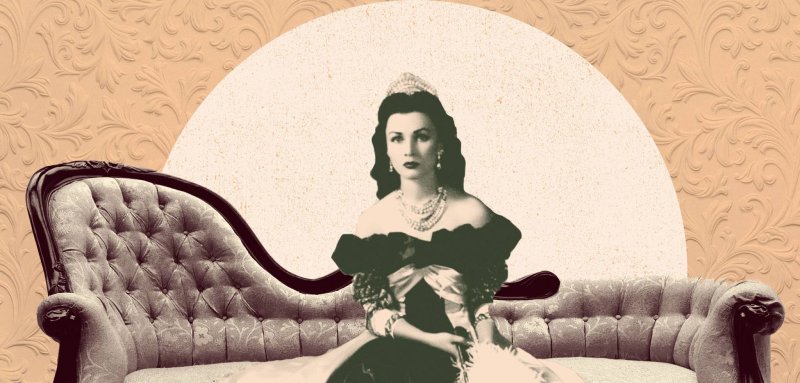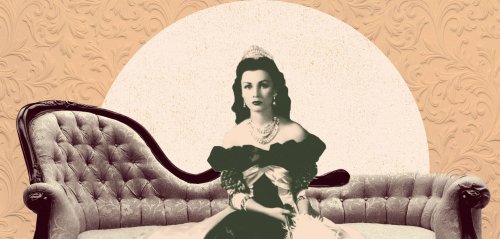The American University in Cairo is holding an exhibition titled: "Princess Fawzia: The Duality of Egyptian Womanhood Seen Through Western and Egyptian Eyes" in commemoration of the sixth anniversary of the passing of a princess who many consider to be the most beautiful in the world: the sister of Egypt's former King Farouk and the first wife of Iran’s last Shah, Mohammad Reza Pahlavi.
The main goal of the exhibition is to display the disparity in the coverage of the former princess between Egyptian and Western media; while the former portrayed Princess Fawzia as the template model of the modern woman, after having led initiatives in healthcare and charities, Western media depicted the princess as merely a political tool to improve relations between Egypt and Iran.
The idea for the exhibition came from American Egyptian student Jana Amin, who undertook a months long journey to collect photos and documents which revealed much about the former princess. The student contacted many historians, including Majed Faraj – an Egyptian historian known for his passion for the Egyptian monarchy, and who lent the exhibition rare photos of the princess, including the album of her imperial wedding to the Shah of Iran in 1939.
The exhibition almost resembles a time portal that chronicles the histories of Egypt and Iran from the year 1921 – the year of Princess Fawzia's birth – until 2013, the date of her death.
The Family Tree
Fawzia was the eldest daughter of Egypt's King Fouad I – who was in turn the seventh son of the 19th century Khedive (ruler of Egypt) Ismail Pasha – and the sister of King Farouk; Her nephew was the short-lived King Fouad II. She was known by the name of Fawzia Chirine, after taking the name of her second husband Colonel Ismail Chirine, an Egyptian diplomat of Circassian origins and Egypt's last War Minister before the revolution of July 1952 which ended the Egyptian monarchy.
Princess Fawzia was born on the 5th of November 1921, to King Fouad I and his wife Queen Nazli; she was their second child, and the younger sister of the Prince Farouk, while her paternal grandfather was Muhammad Ali Pasha, the founder of modern-day Egypt who ruled the country between the years 1805 and 1848.
Meanwhile, her maternal great grand father was a French born officer who served in Napoleon Bonaparte's army – perhaps a reason for her European features. She was educated in Switzerland and was proficient in both French and English.
When Egypt’s Fawzia wanted to divorce Iran’s Shah, a political crisis between Cairo and Tehran ensued and relations were severed in 1948. The official reason for the divorce was the "health hazards threatening the princess because of the Persian climate."
Larger than life, Princess Fawzia favoured personal freedoms over power and was depicted as a symbol of modernity for women in Egypt, yet the West saw her as a political tool used to influence Egyptian Iranian relations.
When she finished her studies, Princess Fawzia returned to Cairo, only to become somewhat of a prisoner in the royal palace, forced to abide by Egyptian rules and customs – a significant departure from her former life in Europe. This would be the source of much anguish for the princess, who loved freedom and did not want to remain imprisoned inside the palace, accompanied by bodyguards and under the watchful eye of servants.
Because of her striking beauty, Fawzia would become the most renowned princess of the Egyptian royal court, as well as the future wife of Iran's Crown Prince Mohammad Reza Pahlavi, who was reported to have fallen in love with her after seeing photos of the princess, deciding to be engaged to her in the year 1938. On the other hand however, a common alternative narrative suggests that the marriage – which received substantial media coverage and was attended by many world leaders – was born out of political factors, with it being suggested that Britain played an intermediary role in the marriage to strengthen political relations between Egypt and Iran.
Nonetheless, Pahlavi's journey to Egypt to marry the princess was not an easy one, as there were no direct flights between Egypt and Tehran; the Crown Prince travelled with an official delegation from Tehran to Iraq by car in February 1939, staying in King Faisal's Palace of Roses, before proceeding to Damascus and then Beirut – from which they boarded a ship to Egypt. Finally, after arriving in the port of Alexandria the royal entourage would take a train to Cairo on the 3rd of March 1939.
A legendary wedding was subsequently held in Cairo on the 15th of March, to be followed by another ceremony in Iran on the arrival of Princess Fawzia.
Two years after the marriage, Pahlavi would ascend to the throne of Iran after the forced exile of his father, Shah Reza Pahlavi, to South Africa following the British-Russian invasion of Iran in 1941. With the young Shah, Fawzia would give birth to Princess Shahnaz on the 27th of October 1940.
Escaping Iran
As Empress, Fawzia lived a life of leisure in Iran. It was during this period that the major European magazines started to take an avid interest in the Queen, publishing her photo on their covers. This did not appeal to Princess Fawzia who started to realize that her imprisonment in Egypt's royal court was simply replaced by a similar imprisonment in Iran's Imperial palace. She could not leave her surroundings like any other ordinary woman. This did not appeal to Fawzia and she decided to rebel, requesting a divorce from the Shah in 1945, with the divorce officially concluded on the 16th of October 1948.
The divorce would cause a political crisis between Cairo and Tehran – reaching the extent of severing all Egyptian-Iranian relations in 1948. At the time, Egypt declared the official reason for the divorce as the "health hazards that threatened the Egyptian princess because of the Persian climate."
In 1948, Princess Fawzia returned to Cairo with her then-eight year old daughter Shahnaz, with the country now under the rule of her brother, King Farouk.
In Cairo, Princess Fawzia would live a new love story with Colonel Ismail Cherine, Egypt's last Minister of War and Navy under the monarchy in 1949; with Cherine the princess would give birth to Nadia and Hussain. Following the toppling of the King during the 23rd of July 1952 revolution, Fawzia preferred to relocate to Alexandria (specifically the area of Smouha), after she was stripped of her official titles and her property was confiscated by the revolution.
Princess Fawzia would refuse to appear in the media, preferring to shun the spotlight and walk the streets without being known to others – her dream throughout her entire life. Iran's former empress would pass away on the 2nd of July 2013 at the age of 92, and was put to rest the next day in a modest funeral ceremony in Cairo which received little interest from Egyptian media. She was carried from the Sayeda Nafisa mosque, where the prayers were held, to be buried next to her second husband Ismail Cherine (who passed away in 1994) in Cairo's Al-Rifa'i mosque.
Princess Fawzia died but her pictures and story remained in memories and in the archives of newspapers and magazines. The American University of Cairo decided to commemorate her life in an exhibition that will remain until the 31st of October.
Raseef22 is a not for profit entity. Our focus is on quality journalism. Every contribution to the NasRaseef membership goes directly towards journalism production. We stand independent, not accepting corporate sponsorships, sponsored content or political funding.
Support our mission to keep Raseef22 available to all readers by clicking here!
Interested in writing with us? Check our pitch process here!






